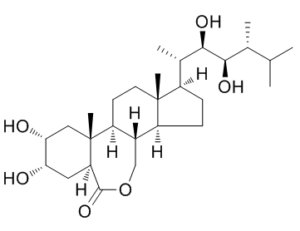Epibrassinolide (24-Epibrassinolide; B1105; BP55)
This product is for research use only, not for human use. We do not sell to patients.

For small sizes, please check our retail website as below: www.invivochem.com
| Size | Price | Stock |
|---|---|---|
| 250mg | $350 | Check With Us |
| 500mg | $450 | Check With Us |
| 1g | $675 | Check With Us |
Cat #: V29309 CAS #: 78821-43-9 Purity ≥ 99%
Description: Epibrassinolide (24-Epibrassinolide; B1105; BP55) is a naturally occurring plant growth hormone which shows great potential to alleviate heavy metals and pesticide stress in plants.
Top Publications Citing Invivochem Products
Publications Citing InvivoChem Products
Product Promise

- Physicochemical and Storage Information
- Protocol
- Related Biological Data
- Stock Solution Preparation
- Quality Control Documentation
| Molecular Weight (MW) | 480.68 |
|---|---|
| Molecular Formula | C28H48O6 |
| CAS No. | 78821-43-9 |
| SMILES Code | C[C@@]1([C@@]2([H])[C@H](C)[C@@H](O)[C@H](O)[C@H](C)C(C)C)[C@](CC2)([H])[C@@](COC3=O)([H])[C@]([C@@]4([C@]3([H])C[C@H](O)[C@H](O)C4)C)([H])CC1 |
| Synonyms | B1105; BP55; B 1105; BP 55; B-1105; BP-55; 24-Epibrassinolide |
| Protocol | In Vitro | Epibrassinolide (EBR) is a biologically active compound of the brassinosteroids, steroid-derived plant growth regulator family. Cells are incubated with various doses (0-100 μM) of Epibrassinolide for 24 or 48 h and cell viability is determined by MTT assay. Epibrassinolide induced cell viability loss in dose- and time-dependent manner compared to untreated samples in LNCaP and DU145 prostate cancer cells. Increasing concentrations of Epibrassinolide is more effective on LNCaP cell viability loss than DU145 cells suggesting that androgen-dependent cells are more sensitive to Epibrassinolide than androgen-independent prostate cancer cells. In further experiments, 25 μM Epibrassinolide is selected due to its moderate cytotoxic effect on both cell lines. The effect of Epibrassinolide treatment is examined on cell proliferation by counting the cell number within 96 h. A higher and earlier inhibition of cell proliferation is observed in LNCaP than DU145 cells. |
|---|
These protocols are for reference only. InvivoChem does not
independently validate these methods.
| Solvent volume to be added | Mass (the weight of a compound) | |||
|---|---|---|---|---|
| Mother liquor concentration | 1mg | 5mg | 10mg | 20mg |
| 1mM | 2.0804 mL | 10.4019 mL | 20.8039 mL | 41.6077 mL |
| 5mM | 0.4161 mL | 2.0804 mL | 4.1608 mL | 8.3215 mL |
| 10mM | 0.2080 mL | 1.0402 mL | 2.0804 mL | 4.1608 mL |
| 20mM | 0.1040 mL | 0.5201 mL | 1.0402 mL | 2.0804 mL |
The molarity calculator equation
Mass(g) = Concentration(mol/L) × Volume(L) × Molecular Weight(g/mol)
Mass
=
Concentration
×
Volume
×
Molecular Weight*
The dilution calculator equation
Concentration(start)
×
Volume(start)
=
Concentration(final)
×
Volume(final)
This equation is commonly abbreviated as: C1 V1 = C2 V2
Concentration(start)
C1
×
Volume(start)
V1
=
Concentration(final)
C2
×
Volume(final)
V2
Step One: Enter information below
Dosage mg/kg
Average weight of animals g
Dosing volume per animal µL
Number of animals
Step Two: Enter the in vivo formulation
%DMSO
+
%
+
%Tween 80
+
%ddH2O
Calculation Results:
Working concentration:
mg/ml;
Method for preparing DMSO master liquid:
mg
drug pre-dissolved in
µL
DMSO(Master liquid concentration
mg/mL)
,Please contact us first if the concentration exceeds the DMSO solubility of the batch of drug.
Method for preparing in vivo formulation:
Take
µL
DMSO master liquid, next add
µL
PEG300, mix and clarify, next add
µL
Tween 80,mix and clarify, next add
µL
ddH2O,mix and clarify.
Note:
- (1) Please be sure that the solution is clear before the addition of next solvent. Dissolution methods like vortex, ultrasound or warming and heat may be used to aid dissolving.
- (2) Be sure to add the solvent(s) in order.




































